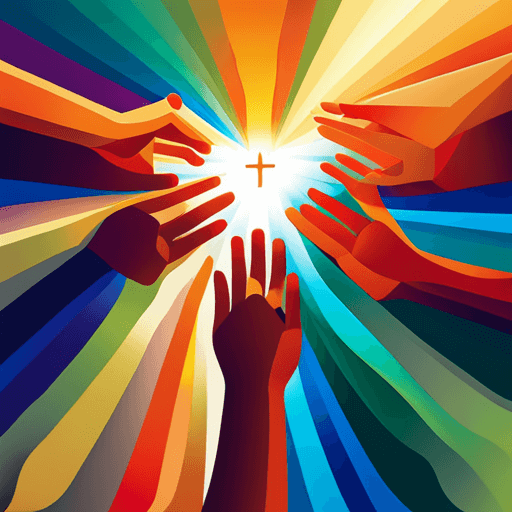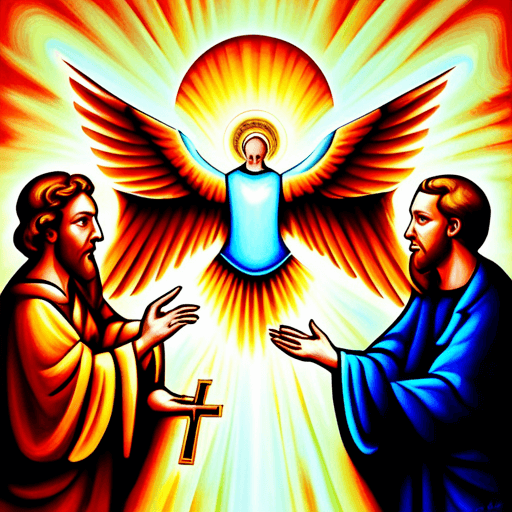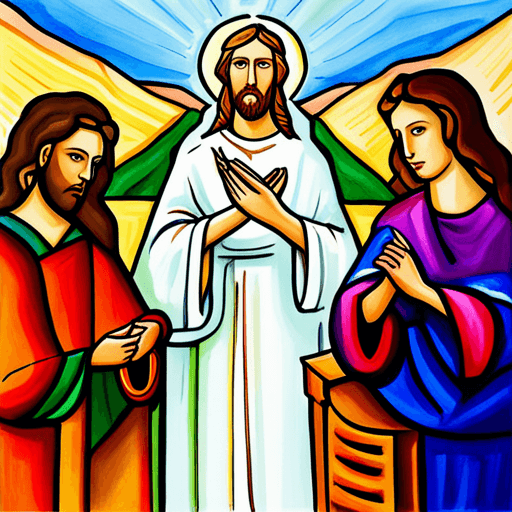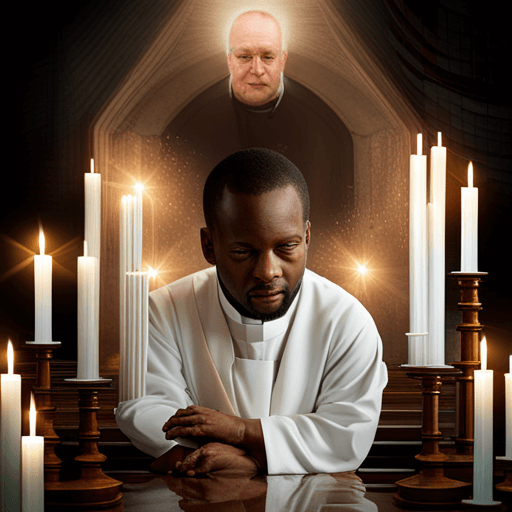Do you ever feel a sense of awe and wonder during Catholic Mass? Do you find yourself moved to tears or filled with joy when praying the Rosary or attending Adoration? The concept of the Trinity, the belief in one God in three persons, is at the heart of Catholic theology and worship.
Understanding how this doctrine affects prayer and worship can deepen your faith and relationship with God. Recognizing the distinct roles of each person of the Trinity in prayer can bring a new depth to your spiritual life.
Through understanding that God is both Father, Son, and Holy Spirit, you can begin to see how each person relates to you personally. The Father provides love and guidance as a parent does for their child, while Jesus serves as a model for how we should live our lives. The Holy Spirit guides us on our spiritual journey and helps us discern God’s will for us.
By recognizing these distinct roles, you can tailor your prayer life to better connect with each person of the Trinity individually.
The Concept of the Trinity in Catholic Theology
Understanding the concept of God as three persons in one is fundamental to Catholic theology, and this belief forms the basis for prayer and worship in the Catholic tradition.
The Trinity is not merely a theological construct but a necessary aspect of salvation, since it reveals the nature of God as love and community.
The Father, Son, and Holy Spirit are distinct persons who share one divine essence, and this unity allows for an intimate relationship between God and humanity.
Moreover, the Trinity has significant implications for Christology since Jesus Christ is understood to be both fully human and fully divine.
In Catholic teaching, Jesus’ humanity was assumed by the second person of the Trinity to bring about redemption through his death on the cross.
Thus, when Catholics pray or worship, they do so with an awareness of their participation in this divine life and love that is made possible through Christ’s sacrifice.
Understanding the Trinity deepens our appreciation for God’s goodness and mercy towards us while also inspiring us to imitate His perfect love within our communities.
Recognizing the Distinct Roles of Each Person of the Trinity in Prayer
You may not have realized it before, but by recognizing the distinct roles of each person in your prayers, you can deepen your connection with God and gain a greater understanding of His love for you.
The Father is the source of all creation and represents infinite power and wisdom. When praying to the Father, you can reflect on His majesty and offer thanksgiving for the blessings He has bestowed upon you.
The Son, Jesus Christ, is the mediator between man and God. In prayerful contemplation, you can thank Him for His sacrifice on the cross that opened up a pathway to salvation. Through divine intercession, Jesus offers us mercy and forgiveness for our sins. When seeking guidance or comfort in times of trouble or distress, we can turn to Him as our advocate who pleads on our behalf before God’s throne.
As we grow closer to each member of the Trinity through prayerful contemplation, we begin to understand more deeply how they work together to bring about our redemption and sanctification.
The Central Role of the Trinity in Catholic Liturgical Celebrations
Get ready to experience the heart of Catholic liturgical celebrations and how it brings you closer to the divine presence.
At the core of these liturgical celebrations is the central role of the Trinity. The Father, Son, and Holy Spirit are all present in every aspect of Catholic worship, from the music and art used in services to the sacraments that Catholics receive throughout their lives.
Trinitarian symbolism can be found throughout Catholic art, with depictions of the Father as an old man, Jesus as a young man or lamb, and the Holy Spirit as a dove or flame. These images help us to understand God’s nature as three persons in one Godhead.
In addition to this visual representation, Trinitarian theology is also reflected in Catholic sacraments such as baptism and confirmation. These sacraments involve invoking all three persons of the Trinity, emphasizing their unity and interconnectedness within our spiritual lives.
Through these practices, we are reminded that we are not alone on our journey toward spiritual fulfillment but rather accompanied by a loving God who desires our flourishing.
Deepening One’s Faith and Relationship with God through Understanding the Trinity
When delving deeper into the divine nature of God, one can experience a sense of awe and wonder that expands their faith beyond what they previously thought possible. Understanding the Trinity is an essential step in deepening one’s relationship with God.
Through exploring Scripture, we can gain insight into the three persons of the Holy Trinity – Father, Son, and Holy Spirit.
Contemplative prayer is another way to deepen our understanding of the Trinity. By quieting our minds and hearts, we allow ourselves to be open to experiencing God’s presence within us. In this state of contemplation, we can better understand how each person of the Trinity works together in harmony to bring about God’s plan for salvation.
As we grow in our understanding and relationship with the Triune God through exploration of Scripture and contemplative prayer, we come closer to fulfilling our ultimate purpose as Catholics: to worship and glorify Him in all that we do.
Applying the Concept of the Trinity to Everyday Catholic Life and Practice
Bringing the concept of the Triune God into our daily lives can enhance our understanding of how God operates in the world around us. It allows us to see that just as there are three persons in one God, there are also three aspects to our relationships with others: love, communication, and unity.
This Trinitarian spirituality helps us to understand that we are called to love others as ourselves, communicate with them openly and honestly, and strive for unity in all things. Incorporating the Trinity into our relationships means recognizing the importance of each person’s unique identity while also valuing their shared connection with one another.
We can pray for guidance in navigating complex relationships and seek to strengthen bonds through acts of kindness and selflessness. Through this approach, we can cultivate a deeper sense of belonging within our families, communities, and beyond.
Ultimately, by embracing a Trinitarian spirituality in all areas of life, we can experience a more profound connection with God and with those around us.
Frequently Asked Questions
How does the concept of the Trinity differ in Catholic theology compared to other Christian denominations?
When it comes to the concept of the Trinity, there are some differences between Catholic theology and that of other Christian denominations.
For example, in Protestant theology, the emphasis is often on the individual’s personal relationship with God rather than on a communal understanding of the Trinity.
In Eastern Orthodox theology, there is a greater emphasis on mystery and contemplation when it comes to understanding the Trinity.
However, in Catholic theology, there is an emphasis on the communal nature of the Trinity – that we are all connected through our shared experience of God’s love.
This understanding can have a profound impact on prayer and worship in the Catholic tradition as it reinforces our sense of belonging in a larger community united by our faith in God.
Can non-Catholics still have a relationship with the Trinity through prayer and worship?
If you’re a non-Catholic seeking a relationship with the Trinity through prayer and worship, there’s no one answer that fits all.
The concept of the Trinity in interfaith relationships is complex and multi-faceted. However, it’s important to understand that Catholic theology holds that there’s only one God who exists in three persons: Father, Son, and Holy Spirit. This belief isn’t exclusive to Catholics but shared by many other Christian denominations as well.
Therefore, non-Catholics can have a relationship with the Trinity through prayer and worship if they believe in this fundamental concept. Nevertheless, each religion has its own unique way of experiencing God’s presence and communicating with Him/Her/Them.
It’s up to you to explore your own spiritual path while respecting other people’s beliefs at the same time.
Are there any specific prayers or rituals in Catholic worship that focus solely on one person of the Trinity?
When it comes to Catholic worship, there are a variety of prayers and devotions that focus on individual persons of the Trinity. For example, the Hail Mary prayer is directed towards Mary, but it also includes a request for her intercession with Jesus (the Son) and God the Father.
Other devotions include novenas to the Holy Spirit or to Saint Joseph, who’s seen as a model of fatherhood in relation to God the Father. Additionally, Trinitarian symbolism can be found throughout Catholic art and architecture, such as depictions of the Holy Trinity as three overlapping circles or an image of Christ on the cross with God the Father above and the Holy Spirit descending like a dove.
These prayers and symbols serve as reminders of the interconnectedness between each person of the Trinity and encourage Catholics to deepen their relationship with all three divine Persons.
How does the Holy Spirit play a role in Catholic liturgical celebrations?
When it comes to Catholic liturgical celebrations, the Holy Spirit plays a pivotal role. The divine person of the Holy Spirit is honored as part of Trinitarian worship practices where all three persons of the Trinity are recognized and given due reverence.
During Mass, for example, the priest invokes the Holy Spirit during the Eucharistic Prayer when he asks God to send down His Spirit upon the bread and wine so that they may become Christ’s body and blood. The faithful also call upon the Holy Spirit in various prayers such as before receiving Communion or in times of need for guidance and strength.
This recognition of the Holy Spirit within Catholic liturgy speaks to a sense of community and belonging within a larger spiritual family whose members honor not just one divine person but all three who work together in unity.
Is it possible for individuals to fully understand the concept of the Trinity, or is it something that can never be fully comprehended?
You, as an individual, may never fully comprehend the concept of the Trinity. The limitations of human understanding prevent us from grasping the fullness of its mystery.
However, rather than being discouraged by this fact, embracing the unknown can lead to spiritual growth. Accepting that certain aspects of our faith cannot be fully comprehended allows us to focus on what we do know and deepen our relationship with God.
This also has implications for community worship; understanding that we are all on a journey towards greater knowledge and acceptance can create a sense of unity within a congregation.
So while we may never fully understand the Trinity, it’s through embracing its mystery that we can find deeper meaning in prayer and worship.
Conclusion
Congratulations! You’ve just learned about how the Trinity affects prayer and worship in the Catholic tradition. By understanding the distinct roles of each person of the Trinity, you can deepen your faith and relationship with God.
The central role of the Trinity in Catholic liturgical celebrations highlights its importance in Catholicism. But it’s not just limited to formal worship – applying the concept of the Trinity to everyday life is crucial for Catholics as well.
Understanding how God exists as three persons in one essence can help guide our thoughts, actions, and intentions towards a more fulfilling and meaningful life. So, go forth with this newfound knowledge and may it inspire you to further explore your faith and continue on your spiritual journey.




